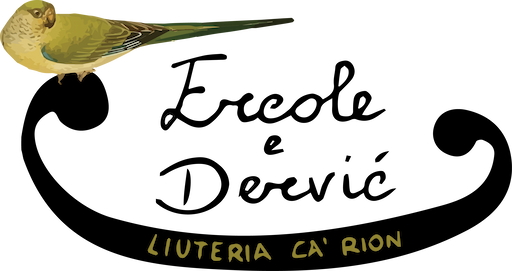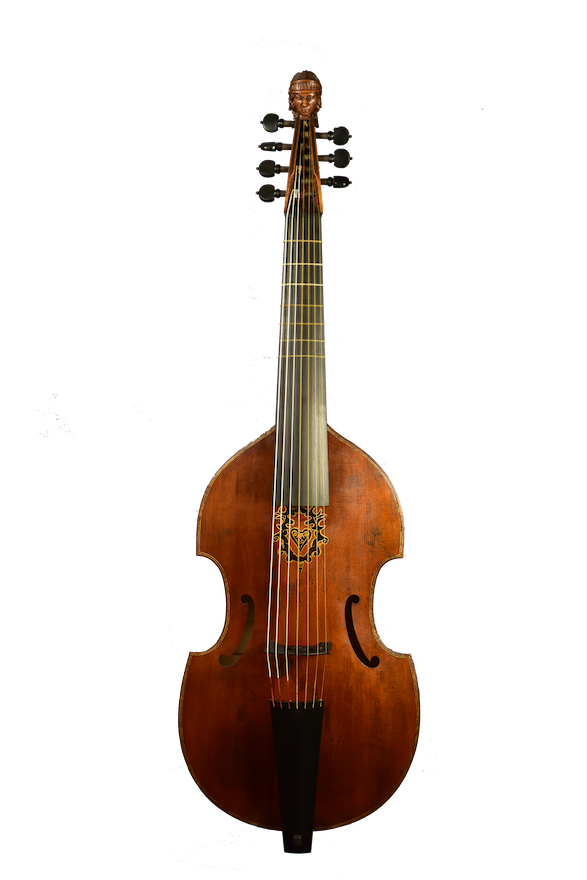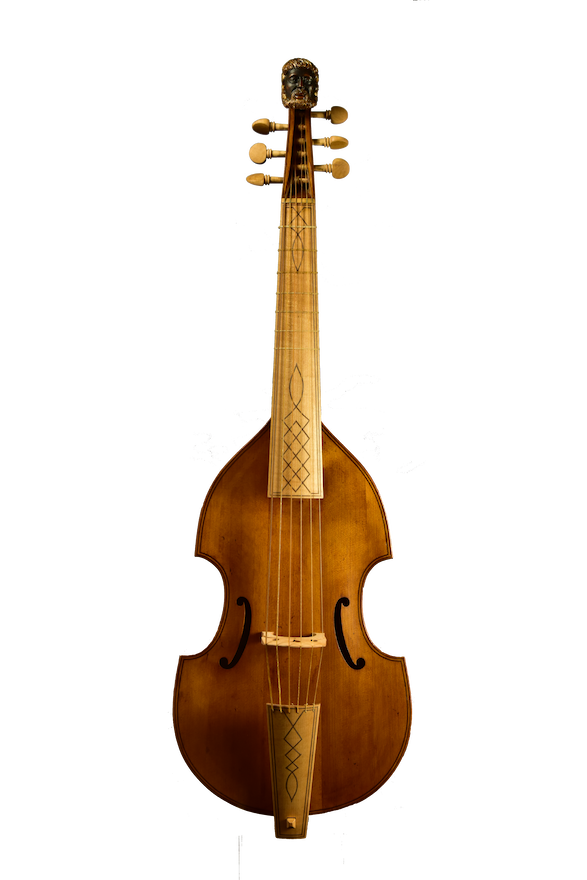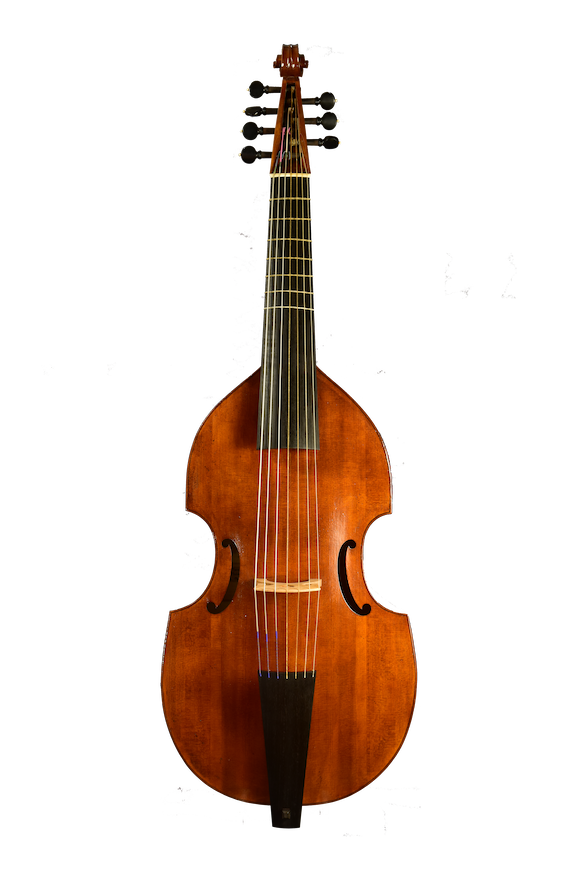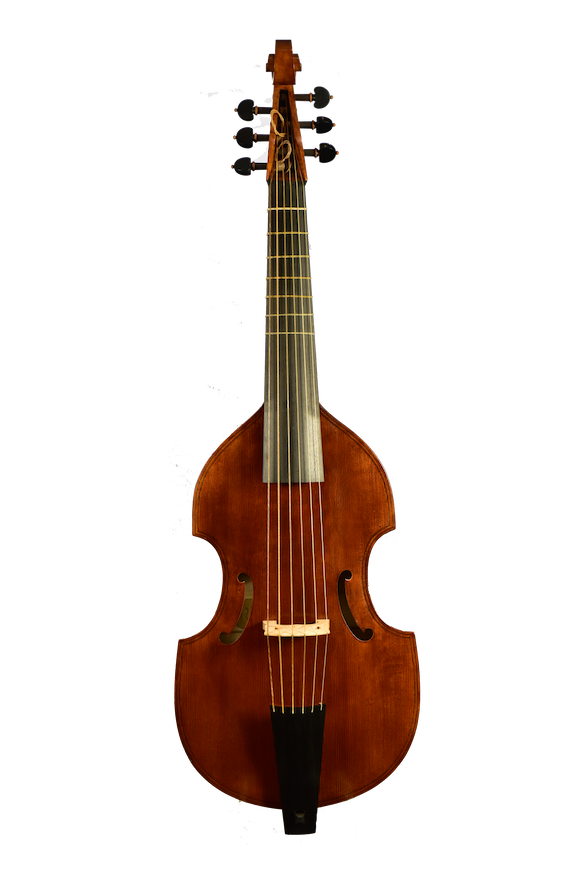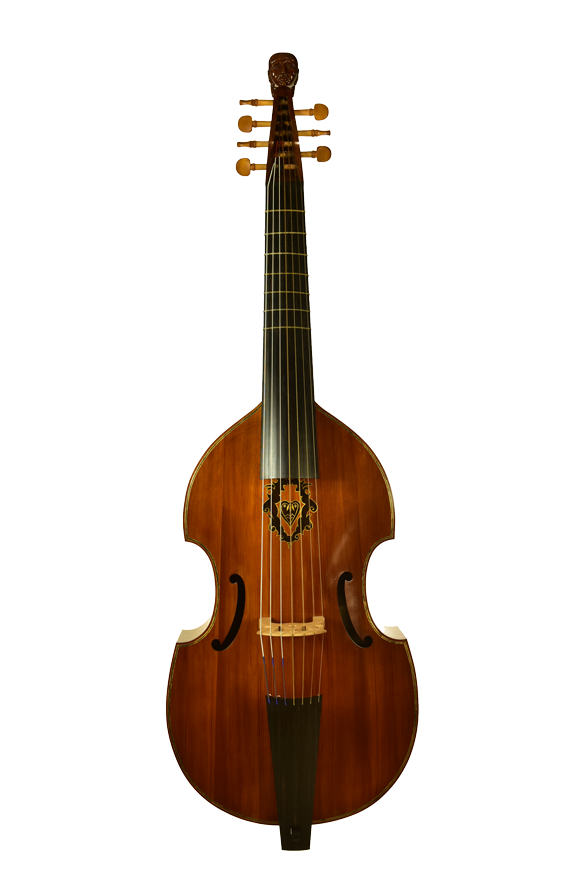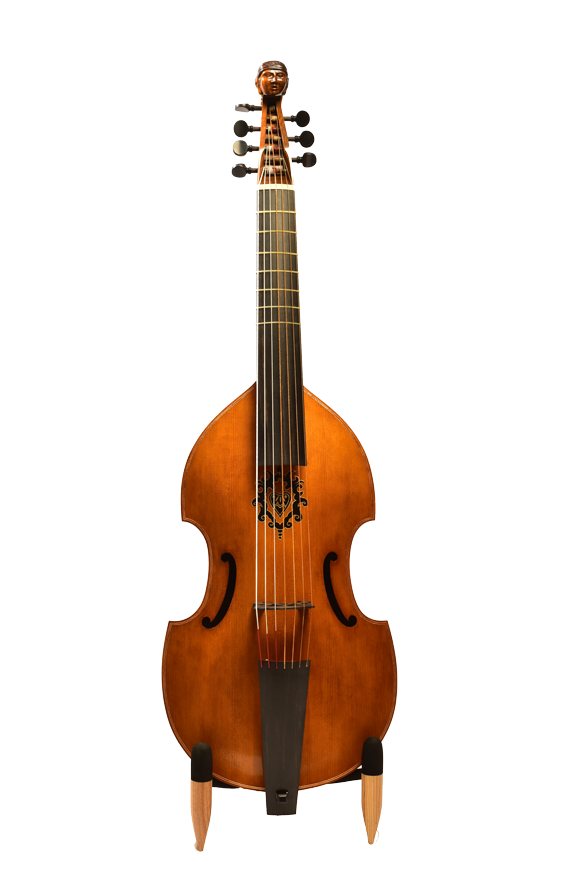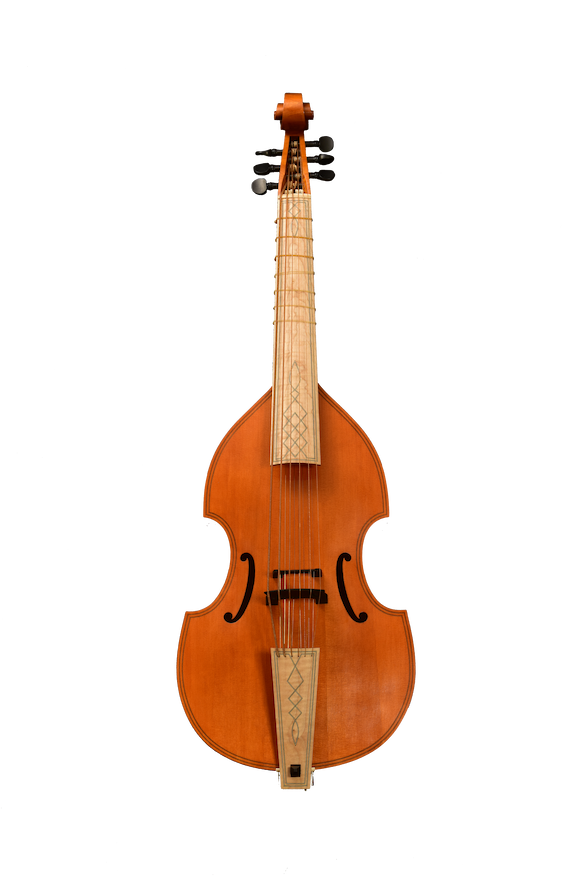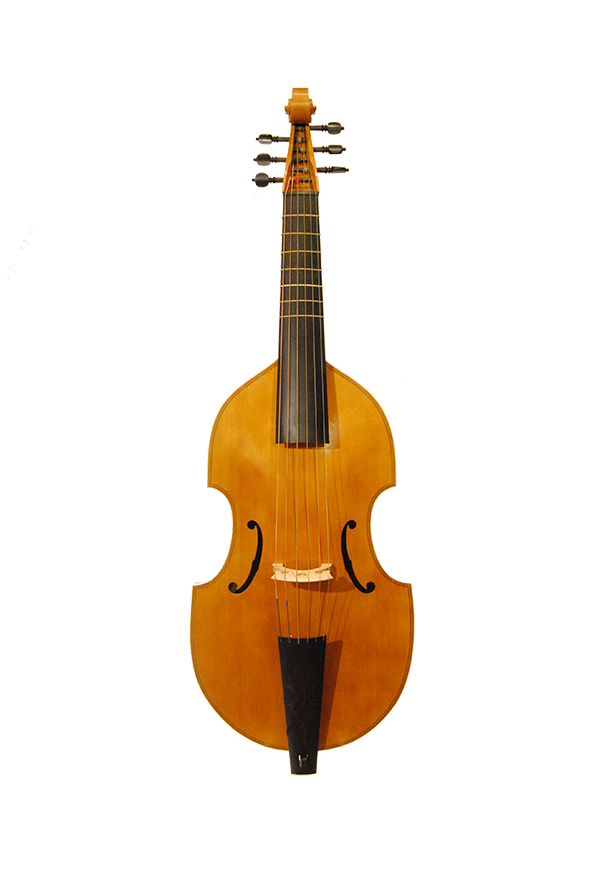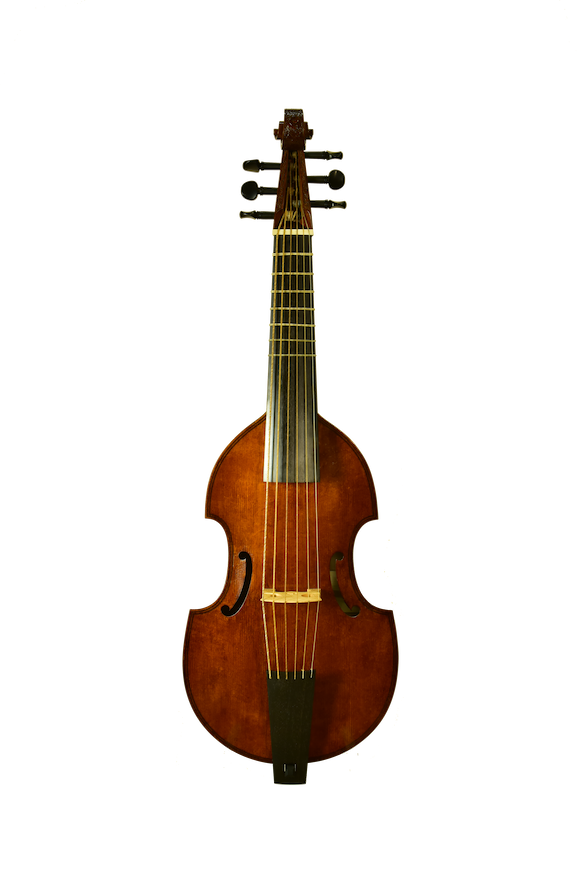












BASS VIOL BASED ON MODEL: MICHEL COLICHON (1691) – Antiqued
We began making this Colichon thanks to a colleague that borrowed us the technical drawings of the instrument, from that moment we replicate it many times and, after some years, thanks to a fortunate series of special events, we met the original instrument kept in a private collection, having the chance to take a close look to that beauty. Right now is surely the model we know better.
We always liked the simplicity of the original design and the beautiful usage of the gilding technique for the ornaments.
The body is big and resonating, this model is made of maple and it’s varnished with oil based on fossil amber and with an antiqued finishing.
The sound-board is made of 5 bent pieces of spruce, resulting very fast in attach, powerfull and full of harmonics.
If we think about french-style gambas we immediately think about this Colichon, in our opinion perfectly matches the definition both in sound colour and construction style.
BASS VIOL BASED ON MODEL: MICHEL COLICHON (1691) – Antiqued
We began making this Colichon thanks to a colleague that borrowed us the technical drawings of the instrument, from that moment we replicate it many times and, after some years, thanks to a fortunate series of special events, we met the original instrument kept in a private collection, having the chance to take a close look to that beauty. Right now is surely the model we know better.
We always liked the simplicity of the original design and the beautiful usage of the gilding technique for the ornaments.
The body is big and resonating, this model is made of maple and it’s varnished with oil based on fossil amber and with an antiqued finishing.
The sound-board is made of 5 bent pieces of spruce, resulting very fast in attach, powerfull and full of harmonics.
If we think about french-style gambas we immediately think about this Colichon, in our opinion perfectly matches the definition both in sound colour and construction style.













TENOR VIOL BASED ON MODEL: JOHN ROSE (1598)
This instrument have almost 35 metres of purfiling decorations basically on every part of it.
The soundboard is made of five bent pieces of Val di Fiemme spruce ( coming from the super dried trunks we found some years ago, that waited us for more than 20 years). The sides, back, fingerboard, tailpiece and neck are made of Bosnian flamed bird’s eye maple.
The pegbox is carved in low relief and the head sculpted, figuring a male character. The face of the man is coloured black and the hair and the beard are gilded with golden leaf.
The whole instrument is varnished with oil varnish based on fossil amber and finished with an antiqued texture.
It’s the second time we make an instrument based on this model. The first one was our version of a Lyra viol with 8 sympathetic strings. We enjoyed very much that project and because of that we made this one with a maple bottom block, giving us the possibility to add sympathetic strings in future, on customer request.
TENOR VIOL BASED ON MODEL: JOHN ROSE (1598)
This instrument have almost 35 metres of purfiling decorations basically on every part of it.
The soundboard is made of five bent pieces of Val di Fiemme spruce ( coming from the super dried trunks we found some years ago, that waited us for more than 20 years). The sides, back, fingerboard, tailpiece and neck are made of Bosnian flamed bird’s eye maple.
The pegbox is carved in low relief and the head sculpted, figuring a male character. The face of the man is coloured black and the hair and the beard are gilded with golden leaf.
The whole instrument is varnished with oil varnish based on fossil amber and finished with an antiqued texture.
It’s the second time we make an instrument based on this model. The first one was our version of a Lyra viol with 8 sympathetic strings. We enjoyed very much that project and because of that we made this one with a maple bottom block, giving us the possibility to add sympathetic strings in future, on customer request.













BASS VIOL BASED ON MODEL: PERSONAL (Nicolas Bertrand 1699 Outline)
For this construction project we followed closely the needs and wishes of our client and we moved away consistently from the original model.
We designed a new empty scroll in a more modern style as requested by the customer, we shortened the string lenght to 69,5 cm (the original is 72.5 cm) and we made the soundboard bent in 4 pieces instead of a carved one.
The back is made of a single piece of slab-cut Bosnian flamed maple (we love so much the aesthetic space/galaxy effect this piece makes).
Sides and neck are made of flamed maple and the soundboard is made of Val di Fiemme spruce.
The varnish is a mixture of self-made oil based on fossil amber and colophony, finished with an antiqued texture.
BASS VIOL BASED ON MODEL: PERSONAL (Nicolas Bertrand 1699 Outline)
For this construction project we followed closely the needs and wishes of our client and we moved away consistently from the original model.
We designed a new empty scroll in a more modern style as requested by the customer, we shortened the string lenght to 69,5 cm (the original is 72.5 cm) and we made the soundboard bent in 4 pieces instead of a carved one.
The back is made of a single piece of slab-cut Bosnian flamed maple (we love so much the aesthetic space/galaxy effect this piece makes).
Sides and neck are made of flamed maple and the soundboard is made of Val di Fiemme spruce.
The varnish is a mixture of self-made oil based on fossil amber and colophony, finished with an antiqued texture.













TENOR VIOL BASED ON MODEL: JOHN ROSE (1600)
An elegant instrument of the english school, with the soundboard made of spruce and the back, sides and neck made of maple.
On customer request we added a small purfiling ornament on the lower part of the back, a hidden decoration for an instrument of a clean style.
Full and equilibrated sound with sweet highs and strong lower notes as we love.
Oil varnish based on fossil amber, finished with an antiqued texture.
TENOR VIOL BASED ON MODEL: JOHN ROSE (1600)
An elegant instrument of the english school, with the soundboard made of spruce and the back, sides and neck made of maple.
On customer request we added a small purfiling ornament on the lower part of the back, a hidden decoration for an instrument of a clean style.
Full and equilibrated sound with sweet highs and strong lower notes as we love.
Oil varnish based on fossil amber, finished with an antiqued texture.













BASS VIOL BASED ON MODEL: MARTIN HOFFMAN (1688)
A big voice hidden in a small body.
The M. Hoffmann 1688 is a beautiful sounding instrument, very balanced and resonant despite the small proportions, that makes it at the same time light-weight and confortable.
We made it following the original model in every aspect except two main personal changes: a two-pieces bent soundboard instead of a carved one and the addition of the 7th string, we love to experiment, study and improve the “sound sculpture” in every instrument we make and with this one the aim was to balance a bit the projection and the clearance of the “German soul” of this kind of instruments with a more round and responsive touch, often belonging to the French authors.
The addition of the 7th string is a matter of adaptability, a characteristic frequently sought after by many musicians. This choice was also “historically defended” by an instrument made by J.C Hoffmann (M.Hoffmann’s son) that have made a 6 strings bass viol in 1714 and modified (probably himself) the next year.
The parchment rosette and the Ebony/Bone mosaic make it precious, elegant and discreet at the same time.
BASS VIOL BASED ON MODEL: MARTIN HOFFMAN (1688)
A big voice hidden in a small body.
The M. Hoffmann 1688 is a beautiful sounding instrument, very balanced and resonant despite the small proportions, that makes it at the same time light-weight and confortable.
We made it following the original model in every aspect except two main personal changes: a two-pieces bent soundboard instead of a carved one and the addition of the 7th string, we love to experiment, study and improve the “sound sculpture” in every instrument we make and with this one the aim was to balance a bit the projection and the clearance of the “German soul” of this kind of instruments with a more round and responsive touch, often belonging to the French authors.
The addition of the 7th string is a matter of adaptability, a characteristic frequently sought after by many musicians. This choice was also “historically defended” by an instrument made by J.C Hoffmann (M.Hoffmann’s son) that have made a 6 strings bass viol in 1714 and modified (probably himself) the next year.
The parchment rosette and the Ebony/Bone mosaic make it precious, elegant and discreet at the same time.













BASS VIOL BASED ON MODEL: MICHEL COLICHON (1691)
We began making this “Pirate Colichon” thanks to a collegue that borrowed us the technical drawings of the instrument, from that moment we replicate it many times and, after some years, thanks to a fortunate series of special events, we met the original instrument kept in a private collection, having the chance to take a close look to that beauty. Right now is surely the model we know better.
We always liked the simplicity of the original design and the beautiful usage of the gilding technique for the ornaments.
The body is big and resonating, the walnut used for back and sides generally gives a low-range pressure to the sound and, at the same time, keeps the instrument pretty light.
The sound-board is made of 5 bent pieces of spruce, resulting very fast in attach, powerfull and full of harmonics.
If we think about french-style gambas we immediately think about this Colichon, in our opinion perfectly matches the definition both in sound colour and construction style.
BASS VIOL BASED ON MODEL: MICHEL COLICHON (1691)
We began making this “Pirate Colichon” thanks to a collegue that borrowed us the technical drawings of the instrument, from that moment we replicate it many times and, after some years, thanks to a fortunate series of special events, we met the original instrument kept in a private collection, having the chance to take a close look to that beauty. Right now is surely the model we know better.
We always liked the simplicity of the original design and the beautiful usage of the gilding technique for the ornaments.
The body is big and resonating, the walnut used for back and sides generally gives a low-range pressure to the sound and, at the same time, keeps the instrument pretty light.
The sound-board is made of 5 bent pieces of spruce, resulting very fast in attach, powerfull and full of harmonics.
If we think about french-style gambas we immediately think about this Colichon, in our opinion perfectly matches the definition both in sound colour and construction style.













DIVISION VIOL BASED ON MODEL: BARACK NORMAN
We were searching for a simple model, with a short scale and a beautiful voice for a customer and after a little bit of research we decided to use this model even if the original instrument is heavily decorated on both body and neck. We clean it up from all of the ornaments and choose for walnut for sides and back in order to boost a bit the low range.
What we like the most of this “Division” viol is the versatility of the size: it’s light and comfortable and the short scale is perfect for consort music, scordature and virtuosistic pieces. Could also perfectly fit to younger musicians and drive them through the course of study.
DIVISION VIOL BASED ON MODEL: BARACK NORMAN
We were searching for a simple model, with a short scale and a beautiful voice for a customer and after a little bit of research we decided to use this model even if the original instrument is heavily decorated on both body and neck. We clean it up from all of the ornaments and choose for walnut for sides and back in order to boost a bit the low range.
What we like the most of this “Division” viol is the versatility of the size: it’s light and comfortable and the short scale is perfect for consort music, scordature and virtuosistic pieces. Could also perfectly fit to younger musicians and drive them through the course of study.













BASS VIOL BASED ON MODEL: ERNST BUSCH
(1630-1641)
When we started studying the Busch/Hiltz instruments we immediately noticed the unconventional proportions and dimensions of those instruments. Some of them are perfectly matching the “classic” measures of the bass, tenor and so on ranges but an another group is right in the middle of those sizes. That’s the case of this little bass, too long to be a tenor and a little bit too short to be a proper bass. It was a little challenge to balance the string tensions to make this beauty properly sing but in the end the result was lovely.
The original manufact was modified over the years, the orginal neck was replaced and some bars and ugly reinforcments were added inside the instrument. We speculated a bit on those aspects, trying to bring a possible originally looking neck and structure to the light. In order to do that we proportioned other original necks and scrolls to this instrument and we cleaned up the inner over-reinforced structure. We worked a bit also on the position of the bridge and the holes to ensure comfortable playability on the festooned shape.
The sound is sweet and full of power despite the small overall proportions.
This is one of the two instruments we photographed and measured at the Germanisches NationalMuseum of Nurnberg and of which we made technical drawings, downloadable in the “Multimedia” section of this site.
BASS VIOL BASED ON MODEL: ERNST BUSCH
(1630-1641)
When we started studying the Busch/Hiltz instruments we immediately noticed the unconventional proportions and dimensions of those instruments. Some of them are perfectly matching the “classic” measures of the bass, tenor and so on ranges but an another group is right in the middle of those sizes. That’s the case of this little bass, too long to be a tenor and a little bit too short to be a proper bass. It was a little challenge to balance the string tensions to make this beauty properly sing but in the end the result was lovely.
The original manufact was modified over the years, the orginal neck was replaced and some bars and ugly reinforcments were added inside the instrument. We speculated a bit on those aspects, trying to bring a possible originally looking neck and structure to the light. In order to do that we proportioned other original necks and scrolls to this instrument and we cleaned up the inner over-reinforced structure. We worked a bit also on the position of the bridge and the holes to ensure comfortable playability on the festooned shape.
The sound is sweet and full of power despite the small overall proportions.
This is one of the two instruments we photographed and measured at the Germanisches NationalMuseum of Nurnberg and of which we made technical drawings, downloadable in the “Multimedia” section of this site.













TENOR VIOL BASED ON MODEL: PAUL HILTZ (1656)
A very precious instrument, that’s what we thought the first time we saw the Hiltz’s tenor.
The original model is one of the 5 festooned viols made by Paul Hiltz in Nurnberg in 1656 (2 treble, 2 tenor and 1 bass).
The whole “consort” was made with quilted ash wood, a very particular, massively flamed wood, used also for carpentery and construction in that period.
Because of that wood the back of the instrument is entirely doubled with spruce, to ensure stability and durability.
The whole instrument is inlayed with purfilings, running through the sound board and the back they make geometrics figures and complicated square knots.
The neck is made originally with plum wood, and in this particular variation we made it with cherry wood.
The head is a carved scroll with the typical Busch-Hiltz Style sad face carved on the front, looking at the audience and reading the music with concentration and toughness.
This is one of the two instruments we photographed and measured at the Germanisches NationalMuseum of Nurnberg and of which we made technical drawings, downloadable in the “Multimedia” section of this site.
TENOR VIOL BASED ON MODEL: PAUL HILTZ (1656)
A very precious instrument, that’s what we thought the first time we saw the Hiltz’s tenor.
The original model is one of the 5 festooned viols made by Paul Hiltz in Nurnberg in 1656 (2 treble, 2 tenor and 1 bass).
The whole “consort” was made with quilted ash wood, a very particular, massively flamed wood, used also for carpentery and construction in that period.
Because of that wood the back of the instrument is entirely doubled with spruce, to ensure stability and durability.
The whole instrument is inlayed with purfilings, running through the sound board and the back they make geometrics figures and complicated square knots.
The neck is made originally with plum wood, and in this particular variation we made it with cherry wood.
The head is a carved scroll with the typical Busch-Hiltz Style sad face carved on the front, looking at the audience and reading the music with concentration and toughness.
This is one of the two instruments we photographed and measured at the Germanisches NationalMuseum of Nurnberg and of which we made technical drawings, downloadable in the “Multimedia” section of this site.













Lyra viol based on model: John Rose (1598)
The lyra viol argument becomes very delicate when you talk about sympathetic strings, very often the number, the position and the tuning of them turns in pure speculation.
That’s exactly what we did, we speculate on it in concert with our client.
Our argument started from the idea that the sympathetic strings were added during the centuries to the old “lyra-viols” and, if they were added, that work had to be as fast and cheap as possible. With this idea in mind, the replacment of a big scroll for 12/14 strings instead of a normal 6 strings scroll looks improbable. In our opinion, more likely, an operation may have been unglue the fingerboard, make a slot inside the neck in order to make the sympathetic string pass trough it and put some little nails in the scroll and some tuning pegs in the lower block. So we decided to anchor the strings on the scroll with little nails we made with a bone “head”, and to tune those strings in the lower part of the instrument with eight harpsichord-style tuning pegs. The result of all of this was really good, the instrument has mantained his original proportion and the tuning of the sympathetic strings is easy thanks to an harpsichord tuning-key. The instrument remains light and balanced and the resonance strings system could almost be defined “reversible”.
Lyra viol based on model: John Rose (1598)
The lyra viol argument becomes very delicate when you talk about sympathetic strings, very often the number, the position and the tuning of them turns in pure speculation.
That’s exactly what we did, we speculate on it in concert with our client.
Our argument started from the idea that the sympathetic strings were added during the centuries to the old “lyra-viols” and, if they were added, that work had to be as fast and cheap as possible. With this idea in mind, the replacment of a big scroll for 12/14 strings instead of a normal 6 strings scroll looks improbable. In our opinion, more likely, an operation may have been unglue the fingerboard, make a slot inside the neck in order to make the sympathetic string pass trough it and put some little nails in the scroll and some tuning pegs in the lower block. So we decided to anchor the strings on the scroll with little nails we made with a bone “head”, and to tune those strings in the lower part of the instrument with eight harpsichord-style tuning pegs. The result of all of this was really good, the instrument has mantained his original proportion and the tuning of the sympathetic strings is easy thanks to an harpsichord tuning-key. The instrument remains light and balanced and the resonance strings system could almost be defined “reversible”.













BASS VIOL BASED ON MODEL: JOHN ROSE (1600)
This English Bass is a good example of the “tailor-made” work we do on our instruments for our clients. In this case the customer was seeking for the greatest simpleness on the aesthetic side of things and for a particular measure proportion for his viola da gamba.
He is a tall man with big hands but in the same time he feels uncomfortable on the left hand with longer string lenghts.
We choose together with him this model that has a quite big belly and we adapted the neck and the string lenght to the his needs.
For the decorations, even if the original model is heavily decorated on both the back and head we tried to follow closely the goal of simplness and kept the whole manufact on the clean side, with one little exeption: in order to quote the John Rose’s decoration we made a “hidden” inlay on the tailpiece, using walnut and ebony and playing with pigments to hide the inlay in a “back on black” ornament.
An english-style “empty” scroll closes the circle of simplness.
BASS VIOL BASED ON MODEL: JOHN ROSE (1600)
This English Bass is a good example of the “tailor-made” work we do on our instruments for our clients. In this case the customer was seeking for the greatest simpleness on the aesthetic side of things and for a particular measure proportion for his viola da gamba.
He is a tall man with big hands but in the same time he feels uncomfortable on the left hand with longer string lenghts.
We choose together with him this model that has a quite big belly and we adapted the neck and the string lenght to the his needs.
For the decorations, even if the original model is heavily decorated on both the back and head we tried to follow closely the goal of simplness and kept the whole manufact on the clean side, with one little exeption: in order to quote the John Rose’s decoration we made a “hidden” inlay on the tailpiece, using walnut and ebony and playing with pigments to hide the inlay in a “back on black” ornament.
An english-style “empty” scroll closes the circle of simplness.













TREBLE viol based on model: HENRY JAYE (1667)
This is by far our favourite treble model. With a string lenght of 40 cm we like to define it “the little big one” and this definition fits perfectly also for its sound and technical aspects. The little/big body brings out a strong voice, with a very present low range and sweet, clean and round high notes. The proportions make it confortable to play with and the fairly big nut is capable to follow the most virtuosistic repertoires. We like to make this instrument with fruit woods as Pear Wood, Walnut and Cherry Wood, in order to enhance the balance between the notes and with the aim of the sweetest sound colour. A little/big jewel of the English tradition.
treble viol based on model: henry jaye (1667)
This is by far our favourite treble model. With a string lenght of 40 cm we like to define it “the little big one” and this definition fits perfectly also for its sound and technical aspects. The little/big body brings out a strong voice, with a very present low range and sweet, clean and round high notes. The proportions make it confortable to play with and the fairly big nut is capable to follow the most virtuosistic repertoires. We like to make this instrument with fruit woods as Pear Wood, Walnut and Cherry Wood, in order to enhance the balance between the notes and with the aim of the sweetest sound colour. A little/big jewel of the English tradition.
